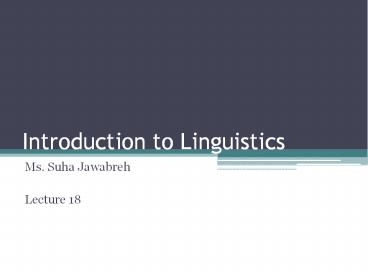Introduction to Linguistics - PowerPoint PPT Presentation
1 / 20
Title:
Introduction to Linguistics
Description:
-If we have the three words : boys, lucky and the , grammar will allow us to have : The lucky boys -This phrase would be referred to as grammatical. – PowerPoint PPT presentation
Number of Views:68
Avg rating:3.0/5.0
Title: Introduction to Linguistics
1
Introduction to Linguistics
- Ms. Suha Jawabreh
- Lecture 18
2
The Components of Language
- 1. Sounds Phonetics and Phonology
- 2. Words Morphology
- 3. Phrases and sentences- Syntax
- 4. Meaning- Semantics and Pragmatics
3
What is Grammar?
- Grammar is a set of rules that govern the
composition of words, phrases and clauses.
4
- -If we have the three words boys, lucky and the
, grammar will allow us to have - The lucky boys
- -This phrase would be referred to as grammatical.
- However , the following combinations of words are
referred to as ungrammatical. - Boys the lucky - lucky boys
the
5
What are the types of grammar?
- 1. Mental grammar
- -Mental grammar describes how speakers produce
and understand linguistic expressions. - This grammar is sub-conscious and not the result
of any teaching. - Psychologists study this type of grammar.
6
- 2. Proper grammar
- -This type of grammar involves what would be
considered as linguistic etiquette. - It identifies what best structures to be used in
a language. - Sociolinguists study this type of grammar.
7
- 3. Language grammar
- -It involves the study and analysis of the
structures found in a language. - Linguists study this type of grammar
8
Language Grammar
- There are two approaches which were used in
grammatical description - 1. The prescriptive approach
- 2. The descriptive approach
9
Prescriptive approach
- It involves labelling the grammatical categories
in sentences ( traditional grammar) - It sets out rules for the correct or proper use
of a languge.
10
Traditional Grammar
- In traditional grammar, many traditional terms
are used in a grammatical description - Examples
- Parts of speech , number, person , tense, voice,
gender (natural gender grammatical gender)
11
Prescriptive rules
- In this approach , grammarians decide what the
correct use of language, not speakers of the
language. - Examples of prescriptive rules
- You must not split an infinitive.
- to slowly drive
- b. You must not end a sentence with a
preposition. - This is the girl I gave the book to.
12
- Other examples that would be considered
improper to prescriptive grammarians - Mary runs faster than me
- Who did you see?
13
The Descriptive Approach
- A descriptive grammar looks at the way a language
is actually used by its speakers and then
attempts to analyse it and formulate rules about
the structure. - - Descriptive grammar does not deal with what
is good or bad language use forms
and structures. - - It is a grammar based on the way a language
actually is and not how some think it should be.
14
What is the difference between the descriptive
approach and the prescriptive approach?
- - Unlike the descriptive approach, The
prescriptive approach deals with what the
grammarians believe to be right and wrong, good
or bad language use not following the rules
will generate incorrect language.
15
Types of descriptive approach
- Structural Analysis
- Immediate constituent analysis.
16
Structural Analysis
- -This method involves the use of test-frames
which can be sentences with empty slots in them - The ___________ makes a lot of noise.
- I heard a ____________ yesterday.
17
- - There are a lot of forms that can fit into the
slots. (E.g. Car ,dog, child ,radio). - All of these examples are NOUNS.
- However, there are nouns that do not fit into
these slots. (E.g. Cathy , it , the dog, the car) - Therefore , new test-frames are required
- ______________ makes a lot of noise
- I heard ___________ yesterday.
18
Immediate Constituent Analysis
- This approach involves dividing linguistic
expressions into constituents - 1. at the word level
- 2. at the phrase level
- 3. At the sentence level
19
Examples
- Mary ate an apple
- The dog followed the boy
- I left the book on the table
20
Another example
- 1. Her father brought a shotgun to the wedding.


















![[DOWNLOAD]⚡️PDF✔️ Speech and Language Processing: An Introduction to Natural Language Processing PowerPoint PPT Presentation](https://s3.amazonaws.com/images.powershow.com/10048007.th0.jpg?_=202406050410)
![[DOWNLOAD]⚡️PDF✔️ Speech and Language Processing: An Introduction to Natural Language Processing PowerPoint PPT Presentation](https://s3.amazonaws.com/images.powershow.com/10048589.th0.jpg?_=20240605013)


![[DOWNLOAD]PDF Key Questions in Second Language Acquisition: An Introduction PowerPoint PPT Presentation](https://s3.amazonaws.com/images.powershow.com/10056095.th0.jpg?_=202406150411)


![[DOWNLOAD]⚡️PDF✔️ Key Questions in Second Language Acquisition: An Introduction PowerPoint PPT Presentation](https://s3.amazonaws.com/images.powershow.com/10056575.th0.jpg?_=20240616071)


![[DOWNLOAD]PDF Key Questions in Second Language Acquisition: An Introduction PowerPoint PPT Presentation](https://s3.amazonaws.com/images.powershow.com/10060153.th0.jpg?_=20240621027)


